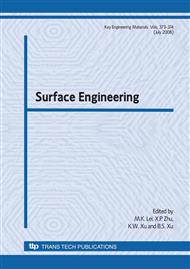p.734
p.738
p.742
p.746
p.750
p.754
p.758
p.762
p.766
Appearance of Mechanical Zinc Coatings and Superficial Pore Sealing Treatment
Abstract:
By using SnSO4 water solution to activate global granular Zn powders of 325 screen mesh, Zn-Sn composite coverage is formed under the action of mechanical impact of the tiny glass beads and work pieces. During and after the formation of coating, acid water liquor will react with metal basal body, and hydrogen gas is bound to emit from the pathway and form micro pores. In addition, there are bond areas between the new and the primary coverage, which may lead to the emergence of micro crack on the coating owing to such causes as too big or uneven impact during plating process, little distortion of global granular zinc dust inside the plating coat, less tight coalescent of the zinc dust flecks. These problems can be confirmed by SEM scanning coating surface and cross section pictures of plating coat. In our study, methyl hydrogen silicone fluid, titanium isopropoxide and benzinum are used as the basal components. This compound has such features as better osmosis for micro pores and cracks formed in the process of dual coverage, strong adhesive force, anti-contraction, high transparence and water proof property. The impact of titanium isopropoxide dosage on the solidifying speed of methyl hydrogen silicone fluid, and that of mechanical plating zinc coating on corrosion proof are studied. Through tests, the proper compound ratio is determined as 11:10:79 of methyl hydrogen silicone fluid to titanium isopropoxide to benzinum(90-120 Centigrade degree). Experiments indicate that when the coating thickness is 0.2 micron, the emergence time of white corrosion on the plating coat doubles, accordingly, that of red rust prolongs, this shows that the anticorrosion of the coverage can be significantly improved through superficial pore sealing in zinc plating coat.
Info:
Periodical:
Pages:
750-753
Citation:
Online since:
March 2008
Authors:
Price:
Сopyright:
© 2008 Trans Tech Publications Ltd. All Rights Reserved
Share:
Citation:


